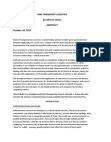ANN TRANSPORT LOGISTICS
By Alfonso Llanes
Much of transportation economics is about finding optimal variables given parameters that describe freight behavior. In this case, we begin with the observed behavior and attempt to find the parameters that permit the specified relationships to fit the data most closely. We are looking at a type of estimation that until recently had not been in the mainstream of econometrics but rather developed in other fields and is now increasingly being used to fit economic relationships—namely neural nets. Artificial neural network (ANN) models are suitable for dealing with problems in which the relationships among the variables are not well known. Examples are problems in which information is not complete or output results are only approximations, as compared to more structured problems with equation-based models. Neural networks are particularly useful for dealing with data sets whose underlying nonlinearities are not known in advance. Among the many possible applications are forecasting and identification of clusters of data attributes. The example used here is typical of the applications of neural nets to economics and finance— how best to predict the future prices of a stock model from Ford Motor Company, and want to predict its future share price by using the share price of a group of related companies—companies that provide inputs to automobile production and companies that produce competing vehicles